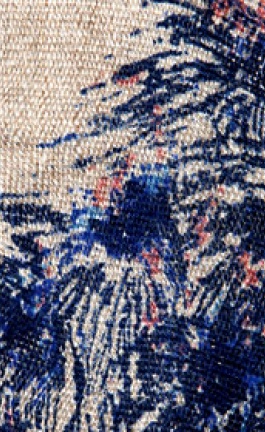Vlassis Caniaris, Tourist, 1974, mixed media, dimensions variable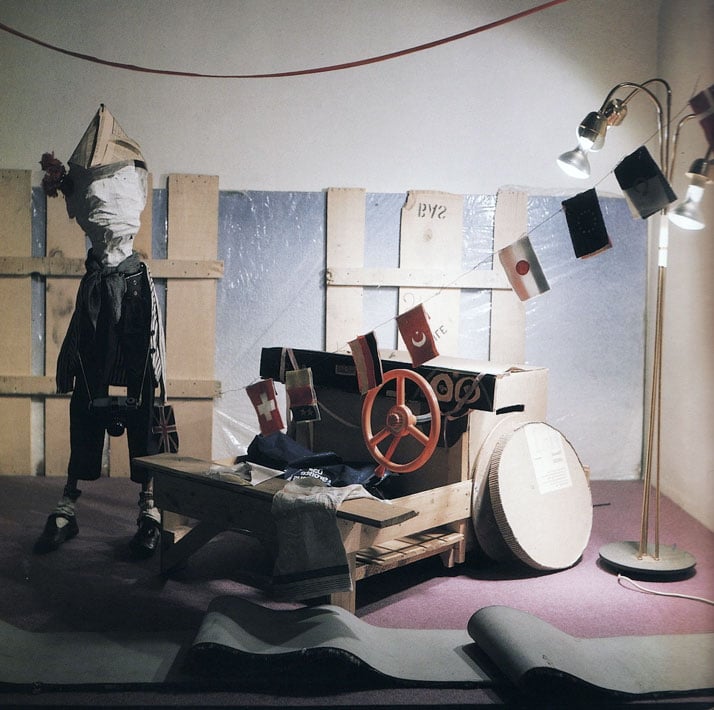
Courtesy of The Breeder, Athens
>>> Guest contribution by Manos Stefanidis - Assistant Professor, University of Athens - for Yatzer.com
In art I’m equally interested for the aesthetic creations as much as for the attitude towards life of the creator. Vlassis Caniaris was a modern artist, politicized but never militized, who acted undisturbed for the past sixty years, from late modernism to the roots of postmodernism encompassing his exclusive morphoplastic material, the body of history and more specifically of modern Greek history, from the civil war of 1944-1949 till the dictatorship of 1967 - 1974 and the restitution of democracy to this day. His work was monoid but polyommatus, like that of mythical Argus, reconnoitering the sociopolitical scene inside and outside and taking a position on occurrence. Acting subsequently as great Art acted: comforting, but also revealing; poignant, but also construing. The distinctiveness of his aesthetic overture is in the details; overcome that, transforms a random object in morphological value that transfuses the paltry bits of precious, murmuring any personal history, any laugh or sob in the ears of eternity.
From his first informelles configurations in 1956-1957 on newspapers or drippings on canvas, Caniaris did not describe, he put forward and proposed. At the age of 30, in 1958 he presented his first solo exhibition in Athens (Gallery "Zygos"), which is historically the first solo exhibition of abstract art ever exhibited in Greece. All his works were dedicated to the departed of an appalling accident that had taken place in the mines of Marcinelle – Belgium. The contradiction is that this exhibition was ‘hit’ by pure Marxist criticism as subjective and highly formalistic and praised by the "bourgeois" critics.
Vlassis Caniaris, During ''Antidoro'' exhibition, November 2009.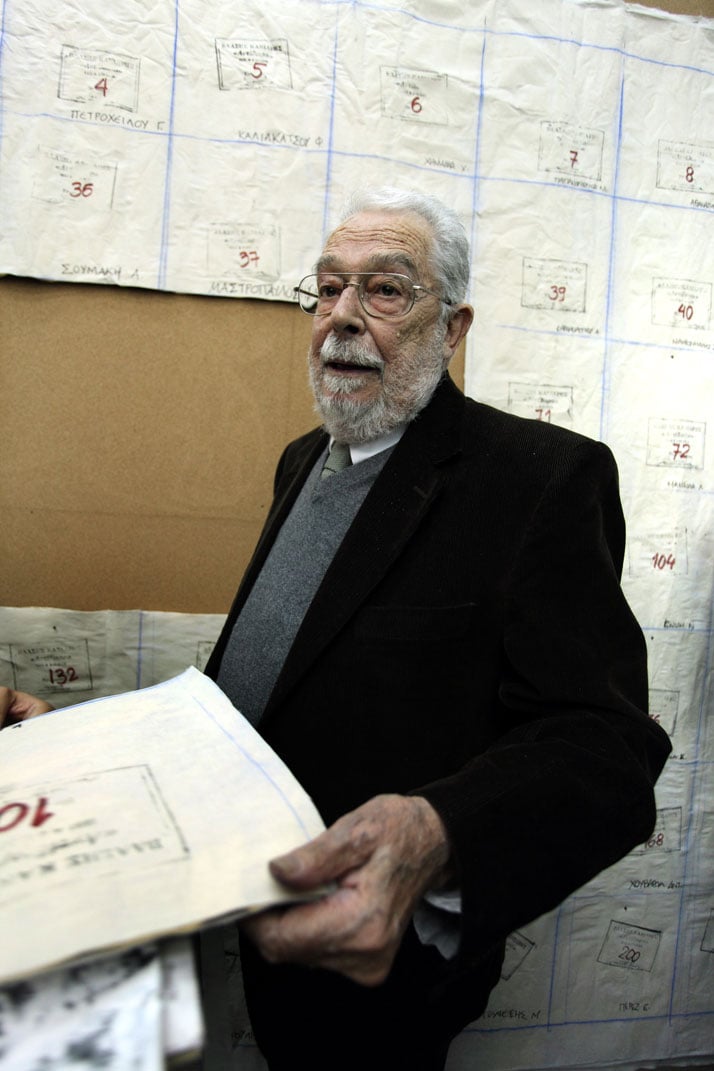
Courtesy of The Breeder, Athens
In 1959 in Naples and Bologna, and in 1960 a solo exhibition at gallery “La Tartaruga” of Rome, provides Caniaris the opportunity to convert the canvas to space and the image to the object. He takes works from the exhibition 'Walls' and dedicates them to ‘the Resistance Movement of Athens and the Civil War,’ in the untitled compositions, where the same material now apologizes for its nature and its content. The scholar of the artist, Michael Fehr, notes: "In the sixties (Caniaris) served in a very personal way the dissolution of the classical concept of the painting and developed his own particular language as a creator of objects.” Personally, I would add a lyrical user of those objects.
Vlassis Caniaris, Untitled, 1963, mixed media, 150x70x28 cm, 
Courtesy of The Breeder, Athens
In a 1961 art construction, entitled ‘space in space’ Caniaris defines blue and white vertical lines on a textured plaster surface in reference to the Greek flag, and then affixes a black box as to erase the effort. The corresponding ‘Flags’ of Jasper Johns are noteworthy since 1955. Only that in this case, the ideological – conflicting element and the emotional pressure is more intense. Caniaris here politicizes even further the famous quote of Seferis ‘Wherever I go, Greece wounds me.’
And all this firmly within the broader research conducted by the European avant-garde from London to Rome and Paris to Berlin trying to articulate his own argument against the advancement of American Modernism: Nouveau Réalisme, L 'Art Autre, Arte Povera, Art and Language are opposing proposals towards versions of Pop and Conceptual Art's coming from the other side of the Atlantic.
1964 is a landmark year: Caniaris navigates to Venice Biennale like a battleship, representing the U.S., Robert Rauschenberg - firmly supported by a host of art critics. The first prize of the Biennale was the rational consequence. As a diversionary measure the independent critic and organizer of exhibitions Pierre Restany presents in the historic La Fenice Theater in Venice in July of that year, anti-exhibition "Proposals for New Greek Sculpting" participants were Daniel, Caniaris and Kessanlis. Cardboard boxes, sheets, ladders, or clothes in wire frames are the "works"; the result was theatrical and scenographical at the same time, as much as humorous and subversive, and has since been classified as disproportionately significant.
Gradually, the artist sets up a human form, anticipating G. Heimonas when he writes in "Enemy of the Poet" that the human form does not exist in nature but is invented in painting.
Vlassis Caniaris, Interrogation, 1969, plaster, wire, fabric, plastic, 110x60x50cm.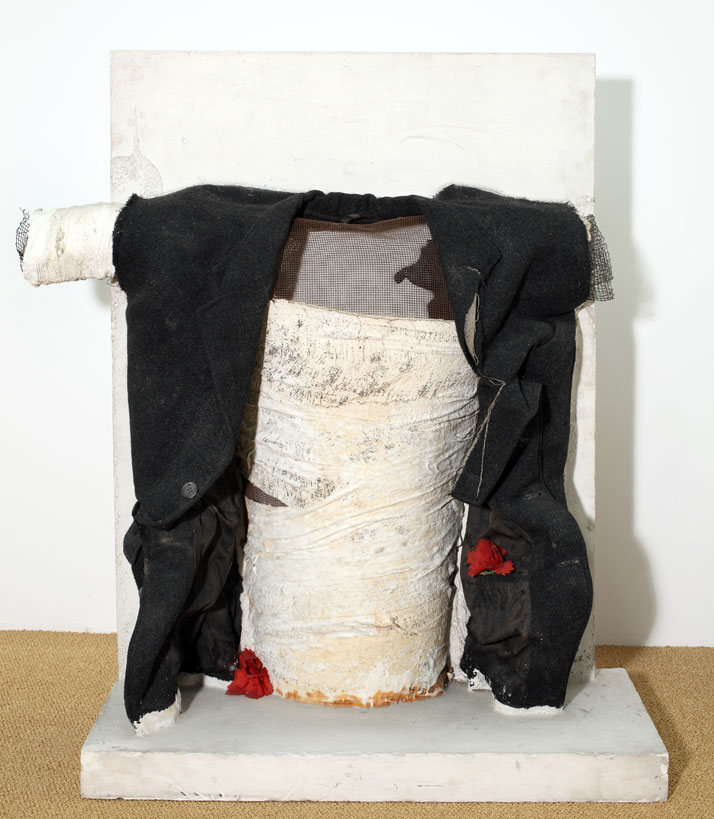
Courtesy of The Breeder, Athens
His next big stop is the exhibition of 1969 in the “New Gallery” in Athens, while dictatorship is raging in Greece and is transferred to the Musée d'Art Moderne de la Ville de Paris in 1970. His works of 1964 seem almost prophetic; they engage gypsum with military belts, barbed wire with carnations and traces of feet with toy soldiers.
Vlassis Caniaris, Youngster, 1974, mixed media, 170x 55x70cm. 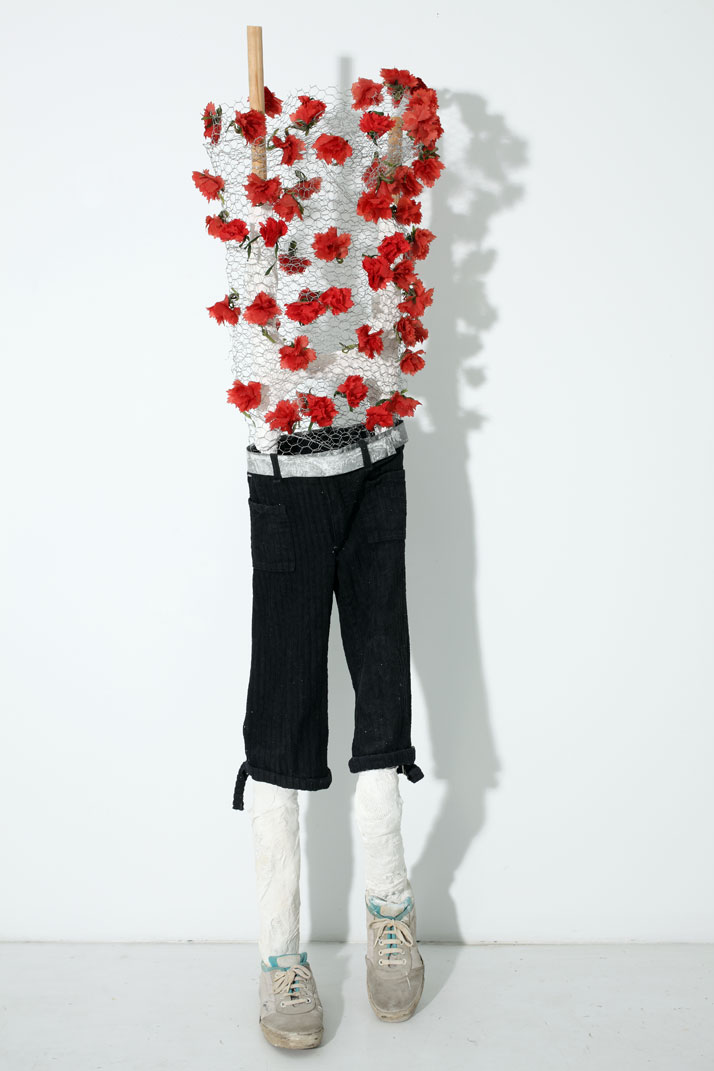
Courtesy of The Breeder, Athens
Caniaris makes a striking political statement - he is already a member of the resistance organization "Democratic Defense," while he constitutes the most sophisticated artistic works in the Greek art scene. His generation, the generation of the 1960’s, whose internationalism is very different to the previous Hellenism of the 1930’s, has brilliant representatives like Chryssa, Takis, G. Kounellis, K. Xenakis, Paul L. Samaras, St. Antonakos, and P. Xagoraris. Among them, lonely and detached is Caniaris. An artist who had simultaneously Tsarouchis and Moralis as professors and Duchamp, Pollock or the Brotheraers and the fellow Tapies, Beuys, Spoerri, Rotella, Merz, Vostell, Arman, Richter, Hacker and many more. It is noteworthy to emphasize the specificity of a true artist who comes from the suburbs but is active and dynamic in cultural art centers such as Rome, Paris or Berlin, using 'native’ materials the “bad question” that the ancient Athenians charged the tragic poet Phrynichus. Furthermore, subsequent to World War II we lived numerous instances of a ‘concerted' leadership, which remained in sensationalism or the surface had little to do with activism of Boccioni, or a juvenile poetic Breton. In our country, and elsewhere, often the sophistication of a form was praised as a revolution, but was merely formalism. We also know how agonizing the market is when looking for a "new product” and how such a reality creates a kind of production history, which acts parallel to the official.
Vlassis Caniaris, Boudoir, 1974, mixed media, 320 x 550 x 300 cm. 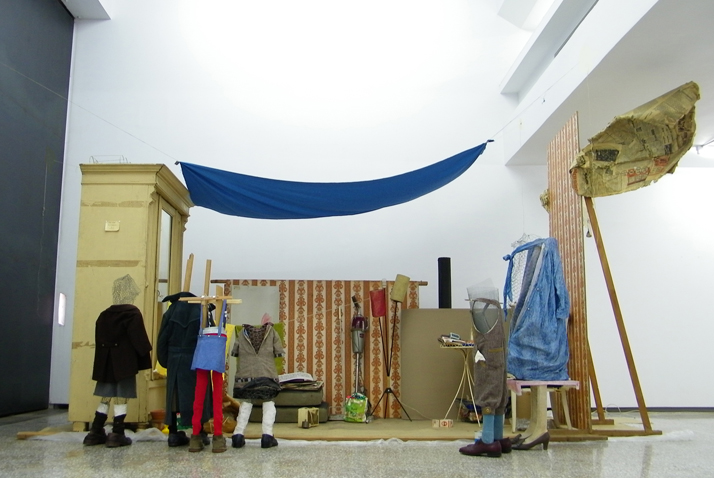
Courtesy of The Breeder, Athens
The real leader comes forward always in direct correspondence with the society that carries it. And this is the key area of achievement of Vlassis Caniaris, an artist who apposite’s the original codes of leadership to extend expressively while working primarily. He herein positions the undisputed bid, using transnational know-how to interpret indigenous experience, at that time-and locally-his identity. That is how his work is the interactive combination of international and national long before any ethnic guide. And it is this exact component that appends to the exploration of the nature of drama, but also led to the necessary clearance.
Vlassis Caniaris, Untitled, 2010, mixed media, 70x40x40 cm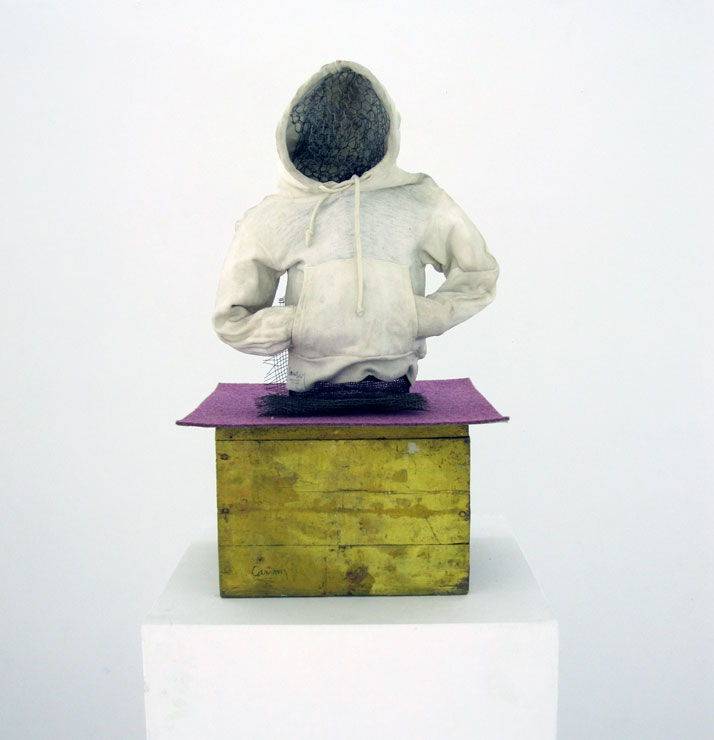
Courtesy of The Breeder, Athens
Caniaris, in a timely manner shaped his personal idiom as he explored the current morphological characters so that to speak directly and original about his personal experience. From tachisme and the lyrical abstract of Marcinelle (1956-1959) to the "Walls" (1959), the repoussé, namely dramatized surfaces visually recorded the time of his generation. A sequence of tragic events, the story itself is what triggers the formation, but devoid of this formation being diverted to a figurative naiveness. Since then the subject of Pop or the cast of Arte Povera is developed - parallel to what happens to the rest of Europe or the U.S. at that time - strategy tools to visualize an entirely personal- experiential mythology. For this artist, Greece of hydrocephalus development and structural contradictions, of the pathetic dictatorship and the junta, the restoration of democracy, but also the rogue immigrants, from where the third world South is promoted to the advanced Northern Europe, transformed into evocative performances by theatrical mannequins of unique design intelligence, as it happened at the exhibition “Gastarbeiter -Fremdarbeiter ,” Berlin, 1974, “Hélas Hellas – The Painter and his Model” Multi-cultural space ‘Fix-Bernier’ 1980, in " Where is North and Where is South?” at the 1988 Venice Biennale, and in the group exhibition "About Homeland” in the House of Cyprus in 1996.
Caniaris was armed with modern history, functioning in a critical and intrusive manner regarding the average taste undermining the current complacency. This is the case of an artist who has experienced groundbreaking expression and succès de scandale, but also a need to overcome, which resulted in a proposal for the body, which is not a single political or social subject, but an ontological, existential figure. The figure of loneliness or margin expressed through aesthetic media.
Vlassis Caniaris, Urinals of History, 1980, installation view at Helas Hellas (The painter and his model), Technohoros Bernier, Fix Brewery, Athens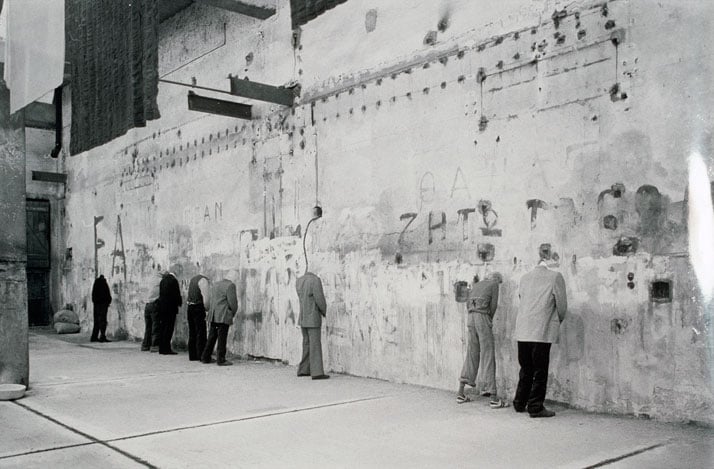
Vlassis Caniaris, Urinals of History, 1980, installation view at Helas Hellas (The painter and his model), Technohoros Bernier, Fix Brewery, Athens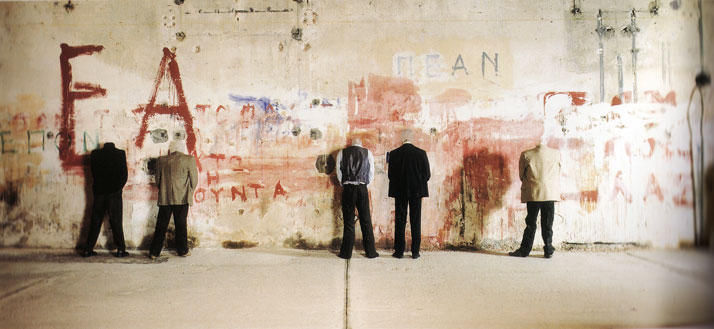
I believe that the “Walls” of Caniaris are the precursors of graffiti and street-art. The mannequins in an ingenious manner join the artist’s articulated model of De Chirico and the figures of Seagal forming an existential proposal, "dilapidated" sculptures across large scale monuments of empty rhetoric and the extravaganza of propaganda. The "Urinal of History" 1979-1980 is addressed in political terms to the "Fountain" of Duchamp (1917) and is a leading postwar work of the Greek avant-garde. When Caniaris was speaking at a given moment in time, unsuspicious about the pan-European problem of immigration and the dimension of this problem (1970) for the unequal relations between Greece and Germany (1973), the class-toxic contrasting North-South (1988) was in numerous cases prophetic. However, above all Caniaris reports since 1980 the oversized populism (Hélas-Hellas Greece, alas) by paying to it the root of the upcoming crisis. As per this, he was one of the few in the whole of Greek intellectuals.
Vlassis Caniaris, Urinals of History, 1980, installation view at Helas Hellas (The painter and his model), Technohoros Bernier, Fix Brewery, Athens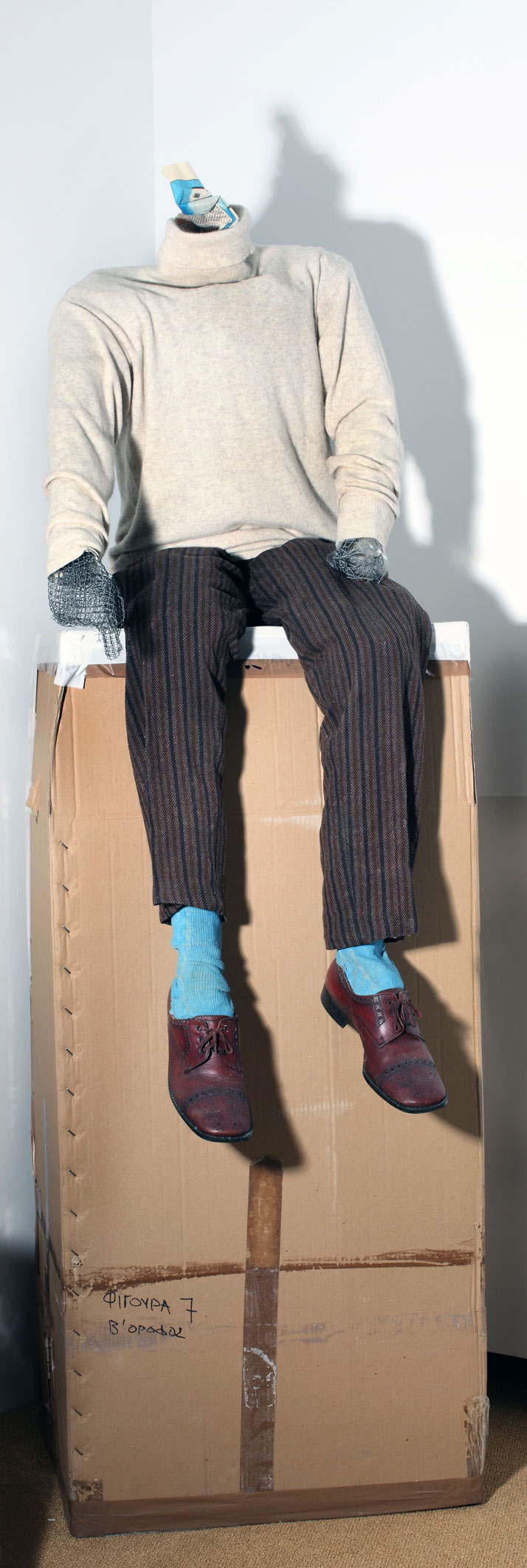
Vlassis Caniaris, Observer, 2005, mixed media, 190x70x70 cm
Courtesy of The Breeder, Athens
>>>>>>>>>>>>>>>>>>>>>>>>>
Οriginal article in Greek:
Βλάσης Κανιάρης (1928-2011) // Κάνοντας τÎχνη με την ιστορία
κείμενο¨Μάνος Στεφανίδης - επ. καθηγητής του Πανεπιστημίου ΑθηνÏν - για το Yatzer.com
Στη τÎχνη μ'ενδιαφÎρει τÏσο το αισθητικÏ δημιοÏργημα Ïσο και η στάση ζωής του δημιουργοÏ του. O Kανιάρης υπήρξε Îνας μοντÎρνος καλλιτÎχνης, πολιτικοποιημÎνος αλλά ποτÎ στρατευμÎνος, που Îδρασε αδιατάρακτα, εδÏ και εξήντα χρÏνια, απÏ τον Ïστερο μοντερνισμÏ ως τα κράσπεδα του μεταμοντÎρνου Îχοντας ως αποκλειστικÏ μορφοπλαστικÏ του υλικÏ το ίδιο το σÏμα της ιστορίας και μάλιστα της νεÏτερης ελληνικής ιστορίας, απÏ τον εμφÏλιο του 1944-49 ως την δικτατορία του 1967-74 και απÏ την αποκατάσταση της δημοκρατίας ως σήμερα. Το Îργο του, μονοειδÎς αλλά πολυÏμματο, σαν τον μυθικÏ εκείνον Îργο, κατοπτεÏει το πολιτικοκοινωνικÏ γίγνεσθαι εντÏς και εκτÏς και παίρνει θÎση κατά περίσταση. Δρα δηλαδή, Ïπως δροÏσε ανÎκαθεν η μεγάλη ΤÎχνη: παρηγορητικά, αλλά και αποκαλυπτικάΠσυγκινÏντας, αλλά και ερμηνεÏοντας. H ιδιαιτερÏτητα της αισθητικής του πρÏτασης Îγκειται στις λεπτομÎρειεςÎ στην υπÎρβαση εκείνη που μεταμορφÏνει το τυχαίο αντικείμενο σε μορφοπλαστική αξία, που μεταγγίζει στο ευτελÎς ψήγματα του πολÏτιμου, που ψιθυρίζει την Ïποια προσωπική ιστορία, το Ïποιο γÎλιο ή λυγμÏ εις επήκοον της αιωνιÏτητας.
ΑπÏ τις πρÏτες informelles του συνθÎσεις το 1956-57 πάνω σε εφημερίδες ή με dripping σε καμβάδες, ο Κανιάρης δεν περιÎγραφε, υπÎβαλε. Σε ηλικία 30 χρονÏν το 1958 παρουσιάζει την πρÏτη του ατομική Îκθεση στην Αθήνα (Γκαλερί «ZυγÏς»), η οποία είναι ιστορικά και η πρÏτη ατομική Îκθεση αφηρημÎνης ζωγραφικής που Îγινε ποτÎ στην Ελλάδα. Îλα τα Îργα ήταν αφιερωμÎνα στους νεκροÏς ενÏς τρομακτικοÏ εργατικοÏ ατυχήματος που είχε γίνει τÏτε στα ορυχεία της Marcinelle στο ΒÎλγιο. Το οξÏμωρο είναι πως αυτήν την Îκθεση χτÏπησε η καθαρÏαιμη μαρξιστική κριτική ως άκρως υποκειμενική και φορμαλιστική, ενÏ την εξήραν «αστοί» τεχνοκριτικοί.
Το 1959 στη Νάπολη και την ΜπολÏνια και το 1960 σε ατομική Îκθεση στη γκαλερί «La Tartaruga» της ΡÏμης, ο Κανιάρης περνά σταδιακά απÏ το τελάρο στο χÏρο και απÏ την εικÏνα στο αντικείμενο. Περνά, δηλαδή, απÏ τους «Τοίχους», Îργα που αφιερÏνει στην Αθήνα της Αντίστασης και του Εμφυλίου, στις άτιτλες συνθÎσεις, Ïπου το ίδιο πια το υλικÏ απολογείται για τη φÏση και το περιεχÏμενÏ του. O μελετητής του καλλιτÎχνη, Michael Fehr, σημειÏνει σχετικά: «Κατά τη δεκαετία του εξήντα (ο Κανιάρης) επιδÏθηκε μ’ Îναν πολÏ προσωπικÏ τρÏπο στη διάλυση της κλασικής Îννοιας του πίνακα και ανÎπτυξε τη δική του ιδιαίτερη γλÏσσα ως κατασκευαστής αντικειμÎνων». Προσωπικά, θα πρÏσθετα και λυρικÏς χρήστης των αντικειμÎνων αυτÏν.
Σε μια κατασκευή του ’61, που την ονομάζει «ΧÏρος μÎσα στο ΧÏρο», πάνω σε μια γÏψινη ανάγλυφη επιφάνεια, ο Κανιάρης χαράζει κάθετες μπλε και άσπρες γραμμÎς που παραπÎμπουν στην ελληνική σημαία και μετά επιθÎτει Îνα μαÏρο τετράγωνο σαν να διαγράφει την προσπάθεια. Οι αντίστοιχες «Σημαίες» του Jasper Johns φιλοτεχνοÏνται ήδη απÏ το 1955. ΜÏνο που στην προκειμÎνη περίπτωση το ιδεολογικÏ-συγκρουσιακÏ στοιχείο και η συναισθηματική φÏρτιση είναι πιο Îντονες. O Κανιάρης εν προκειμÎνω πολιτικοποιεί Îτι περαιτÎρω την πασίγνωστη φράση του ΣεφÎρη «Îπου κι αν πάω η Ελλάδα με πληγÏνει».
Κι Ïλα αυτά σταθερά εντÏς της ευρÏτερης Îρευνας που διεξήγε η ευρωπαÏκή avant-garde απÏ το Λονδίνο ως τη ΡÏμη και απÏ το Παρίσι ως το Βερολίνο προσπαθÏντας να διατυπÏσει το δικÏ της λÏγο απÎναντι στην αμερικανική μοντερνιστική προÎλαση: Nouveau Réalisme, L’ Art Autre, Arte Povera, Art and Language είναι οι αντιρρητικÎς προτάσεις απÎναντι στις εκδοχÎς της Pop ή της Conceptual Art που Îρχονται απÏ την άλλη πλευρά του ΑτλαντικοÏ.
Tο 1964 είναι μια σημαδιακή χρονιά: καταπλÎει στη Biennale Bενετίας σαν θωρηκτÏ, εκπροσωπÏντας τις HΠA, ο Robert Rauschenberg και υποστηρίζεται απÏ στρατιά τεχνοκριτικÏν. Tο A’ βραβείο της διοργάνωσης υπήρξε λογικÏ επακÏλουθο. Ως πράξη αντιπερισπασμοÏ ο ανεξάρτητος κριτικÏς και οργανωτής εκθÎσεων Pierre Restany παρουσιάζει στο ιστορικÏ θÎατρο La Fenice της Bενετίας, τον ΙοÏλιο της ίδιας χρονιάς, την αντι-Îκθεση «Προτάσεις για μια νÎα ελληνική γλυπτική» με συμμετÎχοντες το Δανιήλ, τον Kανιάρη και τον Kεσσανλή. ΧαρτÏκουτα, σεντÏνια, σκάλες ή ροÏχα μÎσα σε συρμάτινους σκελετοÏς αποτελοÏν τα «Îργα», το αποτÎλεσμά τους Ïμως, θεατρικÏτατο, Ïσο και χιουμοριστικά ανατρεπτικÏ, εγγράφεται Îκτοτε δυσανάλογα σοβαρÏ.
Σταδιακά, ο καλλιτÎχνης συγκροτεί μιαν ανθρÏπινη μορφή, προλαβαίνοντας τον Γ. Xειμωνά Ïταν λÎει στον «ΕχθρÏ του ποιητή» Ïτι η μορφή του ανθρÏπου δεν υπάρχει στη φÏση αλλά την επινÏησε η ζωγραφική.
ΕπÏμενος μεγάλος σταθμÏς η Îκθεση του 1969 στη «NÎα Γκαλερί» της Aθήνας, ενÏ η δικτατορία μαίνεται στην Eλλάδα, και η μεταφορά της στο Musée d’Art Moderne de la Ville de Paris το 1970. Îργα του 1964, θαρρείς προφητικά, εμπλÎκουν τους γÏψους με τις στρατιωτικÎς ζÏνες, τα συρματοπλÎγματα με τα γαρίφαλα και τα ίχνη των πελμάτων με τους μολυβÎνιους στρατιÏτες.
O Kανιάρης πραγματοποιεί μια συνταρακτική πολιτική δήλωση –είναι ήδη μÎλος της αντιστασιακής οργάνωσης «Δημοκρατική Îμυνα», ενÏ παράλληλα συγκροτεί την πιο προωθημÎνη καλλιτεχνικά ενÏτητα Îργων στον ελληνικÏ χÏρο. Η γενιά του, η γενιά του ’60, της οποίας ο διεθνισμÏς διαφοροποιείται Îντονα προς τον ελληνοκεντρισμÏ της προηγοÏμενης, της γενιάς του ’30, Îχει εκπροσÏπους λαμπροÏς, Ïπως η XρÏσα, ο Tάκις, ο Γ. KουνÎλλης, ο K. Ξενάκης, ο ΠαÏλος, ο Λ. Σαμαράς, ο Στ. Aντωνάκος, ο Π. Ξαγοράρης. Aνάμεσά τους, μοναχικÏς και ξεχωριστÏς, ο Kανιάρης. Îνας δημιουργÏς που είχε ταυτοχρÏνως δασκάλους τον TσαροÏχη, τον MÏραλη αλλά και τον Duchamp, τον Pollock ή τον Brotheraers και συνοδοιπÏρους τον Tapies, τον Beuys, τον Spoerri, τον Rotella, τον Merz, τον Vostell, τον Arman, τον Richter, τον Hacker κ.ά.. EδÏ πρÎπει να υπογραμμιστεί η ιδιαιτερÏτητα ενÏς καλλιτÎχνη που προÎρχεται μεν απÏ την περιφÎρεια αλλά που ενεργοποιείται σε καλλιτεχνικά κÎντρα, Ïπως η PÏμη, το Παρίσι ή το Bερολίνο, χρησιμοποιÏντας ως υλικά «ιθαγενή» στοιχεία, τα «οικεία κακά» που καταλÏγισαν οι αρχαίοι Αθηναίοι στον τραγωδÏ ΦρÏνιχο. Παράλληλα, μετά τον B’ ΠαγκÏσμιο ΠÏλεμο ζήσαμε πάμπολλες περιπτÏσεις μιας «συμπεφωνημÎνης» πρωτοπορίας, η οποία, παραμÎνοντας στον εντυπωσιασμÏ Î® την επιφάνεια, είχε ελάχιστες σχÎσεις με τον ακτιβισμÏ ενÏς Boccioni, ή την ποιητική παραβατικÏτητα ενÏς Breton.
Στον τÏπο μας, αλλά και αλλοÏ, συχνά η εκζήτηση μιας φÏρμας εγκωμιάστηκε ως επανάσταση, ενÏ απλÏς ήταν φορμαλισμÏς. Γνωρίζουμε επίσης, πÏσο εναγÏνια αναζητεί η αγορά το «καινοÏριο προÏÏν» και πÏσο μια τÎτοια πραγματικÏτητα δημιουργεί Îνα είδος παρα-ιστορίας που δρα παράλληλα προς την επίσημη. H αληθινή Ïμως, πρωτοπορία προκÏπτει πάντα σε άμεση αντιστοίχηση προς την κοινωνία η οποία την κυοφορεί. Kι αυτÏς είναι ο ουσιαστικÏς χÏρος δράσης του Bλ. Kανιάρη, ενÏς καλλιτÎχνη που οικειοποιείται τους αυθεντικοÏς κÏδικες της πρωτοπορίας για να τους επεκτείνει εκφραστικά λειτουργÏντας πρωτογενÏς. O ίδιος, και εδÏ Îγκειται η αδιαμφισβήτητη προσφορά του, χρησιμοποιεί τη διεθνική του θητεία για να ερμηνεÏει το εντÏπιο βίωμα, τη δεδομÎνη –χρονικά και τοπικά– ταυτÏτητά του. Îτσι το Îργο του αποτελεί το διαλεκτικÏ συνδυασμÏ του διεθνοÏς και του εθνικοÏ πολÏ πιο πριν απÏ τον οποιονδήποτε ethnic συρμÏ. Και είναι αυτÏ ακριβÏς το στοιχείο που προσδίδει στην Îρευνά του το χαρακτήρα του δράματος, αλλά και οδηγείται στην αναγκαία κάθαρση.
O Kανιάρης διαμÏρφωσε εγκαίρως το προσωπικÏ του ιδίωμα διευρÏνοντας τους ισχÏοντες μορφοπλαστικοÏς χαρακτήρες Ïστε να εκφραστεί πρωτÏτυπα και άμεσα το ατομικÏ του βίωμα. ΑπÏ το tachisme και τη λυρική αφαίρεση της Marcinelle (1956-59) ως τους «Tοίχους» (1959), τις ανάγλυφες δηλαδή δραματοποιημÎνες επιφάνειες στις οποίες καταγράφεται εικαστικά το χρονικÏ της γενιάς του. Mια σειρά τραγικÏν γεγονÏτων, η ιστορία η ίδια, είναι αυτή που πυροδοτεί τη δημιουργία του, χωρίς Ïμως η δημιουργία αυτή να εκτρÎπεται σε αναπαραστατικÎς αφÎλειες. Îκτοτε το αντικείμενο της Pop ή το απÏρριμμα της Arte Povera καθίστανται –παράλληλα με Ï, τι συμβαίνει και στην υπÏλοιπη EυρÏπη ή τις HΠA την εποχή εκείνη– στρατηγική εργαλεία για να οπτικοποιήσει μιαν απολÏτως προσωπική-βιωματική μυθολογία.Για τον καλλιτÎχνη αυτÏν η Eλλάδα της υδροκÎφαλης ανάπτυξης και των δομικÏν αντιφάσεων, της γελοίας δικτατορίας και της μεταπολίτευσης, αλλά και οι μετανάστες-παρίες, που απÏ τον τριτοκοσμικÏ NÏτο προωθοÏνται αγεληδÏν στον προηγμÎνο ευρωπαÏκÏ Bορρά, μετατρÎπονται σε υποβλητικά δρÏμενα, με θεατρικÏτητα μανεκίνα μοναδικής σχεδιαστικής οξÏτητας, Ïπως συνÎβη στην Îκθεση «Gastarbeiter-Fremdarbeiter», Bερολίνο, 1974, στο «Hélas Hellas - O Zωγράφος και το MοντÎλο του», TεχνοχÏρος «Φιξ-Bernier» 1980, στο «ΠοÏ ο Βορράς και ΠοÏ ο ΝÏτος;» στη Biennale Βενετίας το 1988 ή στην ομαδική Îκθεση «Περί Πάτρης» στο «Σπίτι της ΚÏπρου» το 1996.
O Kανιάρης, με Ïπλο τη σÏγχρονη ιστορία, λειτουργεί κριτικά και παρεμβατικά ως προς το μÎσο γοÏστο υπονομεÏοντας τον ισχÏοντα εφησυχασμÏ. ÎÎχουμε δηλαδή την περίπτωση ενÏς δημιουργοÏ που βίωσε την πρωτοποριακή Îκφραση και ως succès de scandale, αλλά και ως ανάγκη για υπÎρβαση και που κατÎληξε σε μια πρÏταση σÏματος, το οποίο δε συνιστά μÏνο πολιτικÏ Î® κοινωνικÏ υποκείμενο, αλλά οντολογική, υπαρξιακή φιγοÏρα. Tη φιγοÏρα της μοναξιάς ή του περιθωρίου διατυπωμÎνη με μÎσα αισθητικά.
Οι “τοίχοι” του Κανιάρη αποτελοÏν πιστεÏω τους προδρÏμους του γκράφιτι και της street-art. Τα μανεκίνα του ενÏνουν ιδιοφυÏς τα ανδρείκελα του De Chirico και τις φιγοÏρες του Seagal αποτελÏντας πρÏταση υπαρξιακής, “φτωχικής” γλυπτικής απÎναντι στα μεγαλÏσχημα μνημεία της κενής ρητορείας και της φαντασμαγορικής προπαγάνδας. Το “Ουρητήριο της Ιστορίας” του απÏ το 79-80 απευθÏνεται με Ïρους πολιτικοÏς στο ¨”Ουρητήριο” του Duchamp του 1917 και αποτελεί τι κορυφαίο μεταπολεμικÏ Îργο της Ελληνικής avant-garde. Ο Κανιάρης μιλÏντας σε χρÏνο ανÏποπτο για τους μετανάστες και την πανευρωπαÏκή διάσταση του προβλήματος (1970), για τις άνισες σχÎσεις Ελλάδας-Γερμανίας (1973), για την ταξική-τοξική αντίθεση Βορρά-ΝÏτου (1988) υπήρξε πολλαπλά προφητικÏς. ΠερισσÏτερο Ïμως απ' Ïλα ο Κανιάρης, απÏ το 80 ακÏμη, καταγγÎλλει τον γιγαντοÏμενο λαÏκισμÏ (Hélas -Hellas Ελλάδα-Αλίμονο) αποδίδοντας σε αυτÏν τη βασική αιτία της επερχÏμενης κρίσης. Ως προς αυτÏ υπήρξε Îνας απÏ τους ελάχιστους μÎσα στο σÏνολο της ελληνικής διανÏησης.
Recent Articles

Art Athina 2024: Highlights from Greece's Annual Contemporary Art Fair






